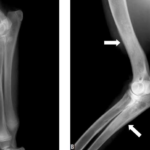Disease description in this species:
Definition
“Limber tail” or “cold tail” is a condition in which working or active dogs suddenly develop a limp tail. The tail either hangs down from the tail base or is held out horizontally for several inches from the tail base then turns straight down or at an angle below horizontal.
The condition was first described by people working with hunting dogs, primarily pointers and Labrador retrievers. The condition has also been seen in the coonhound, beagle, golden retriever, flat-coated retriever, English setter, golden retriever, fox hound and other breeds. Affected dogs usually have a history of being transported for a prolonged time in a cage or crate; a hard workout prior to onset; prolonged swimming; or exposure to cold or wet weather.

Cause:
The condition is believed to be a sprain or strain of the muscle groups supporting the tail or used to wag the tail. Over exertion of the tail is considered the underlying problem.
Clinical Signs
In addition to the signs described above, sometimes the hair on the dorsal aspect of the proximal tail may be raised, possibly from swelling of the soft tissues at the base of the tail. Affected dogs may exhibit pain and resent palpation of an area 3-4 inches (8-10 cm) from the tail base. They may also be lethargic. The condition has a somewhat seasonal occurrence in that it is more likely to develop when dogs start heavy training in the fall and exposure to cold weather occurs.
Diagnosis

A presumptive diagnosis is based upon history, signalment and compatible clinical signs. Diagnostic tests are rarely performed but abnormal findings performed at specilaty facilities on thermography, electromyography, and scintigraphy further supported the diagnosis.1 Radiographs of the lumbosacral-coccygeal area are normal.
Breeds most commonly affected:
Beagle
Coonhound
Flat-coated retriever
Hunting dogs
Labrador retriever
Pointer
Sex predilection:
None
Age predilection:
Young adult
| Diagnostic procedures: | Diagnostic results: | |
| Electromyography of muscle (EMG) | Denervation potentials present |
Treatment/Management/Prevention:
SPECIFIC THERAPY
No specific therapy has been proposed for this condition.
SUPPORTIVE THERAPY
1) It is best to rest the dog. Most dogs recover spontaneously within a few days to weeks. During recovery the tail may hang to one side. Most owners and trainers familiar with the condition do not seek veterinary assistance. Less than 50% of affected dogs experience a recurrence.7
2) Anecdotal reports suggest that nonsteroidal anti-inflammatory drugs administered within 24 hours after onset hasten recovery.
PROGNOSIS
The majority of affected dogs recover completely. Only 16% are left with a permanently altered tail conformation.1


